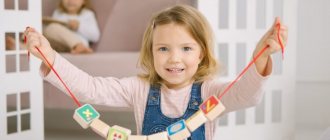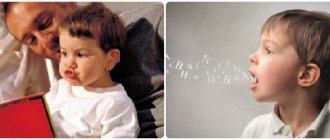When a child appeared in our house, everyone, without exception, couldn’t wait for him to start talking. But the first year passed, the second was coming to an end, and the baby continued to remain silent, uttering only the semblance of words. My husband and I, fueled by the instructions of our grandparents, whose children “read poetry at one and a half years old,” began to look for deviations, illnesses of the child and mistakes in upbringing. When should you start sounding the alarm? To answer this question, you should listen to your child and your own heart.
- How does speech develop in children under 2 years of age?
- Speech norms for a 2 year old child
- The best games for developing a child's speech at 2 years old
- What to do if the child has not started speaking?
- My experience of speech development in a child
How does speech develop in children under 2 years of age?
Speech development occurs in stages, and each stage is present in any case , regardless of the nationality and language spoken by others. My child was no exception and went through all stages of speech development. Some stages lasted longer, some shorter, but in the end the child spoke fully.
- Scream. With my first child, I had a hard time understanding why my daughter was screaming, but with my second baby, I unmistakably learned to recognize when he was screaming from hunger or when he was just bored. From the moment of birth, the only way for a child to communicate with mom and dad is to cry. With it, he expresses feelings of hunger and thirst, physical discomfort, draws attention to himself if he is hot or cold, clothes are tight or uncomfortable, and also if the baby is in pain. Attentive parents can also quickly learn to distinguish between different types of crying.
- Booming. From about 3 months, newborns begin to hum: most often this happens when the baby is happy and thus expresses a feeling of satisfaction. However, this period does not have to coincide with the beginning of the party. My first daughter began to walk only at 4.5 months, being completely healthy and without any deviations, but my son was already walking and singing in every way at 2 months. The child learns to move his tongue to pronounce sounds and trains the speech apparatus in every possible way. The buzz is usually reproduced in the form of the words “Agu”, “Ua”, “Gaaa”, “Guuu”.
INTERESTING! All nations of the world have children who walk in exactly the same way.
- Pronunciation of syllables and babbling. By about 7-8 months, children can pronounce different syllables, and they are not yet associated with certain images and words. The baby may say “Ma-ma-ma-ma-ma” without meaning his mother at all. However, this is an important stage in which the child masters the main part of sounds.
- First words. At the age of one, my first child could only say so much: “baba”, “dad”, “yum-yum” and a couple more phrases from his personal repertoire that cannot be translated into human language. By the age of one year, a baby can know and pronounce up to 10 words. Moreover, these may not always be full words. For example, instead of the word “dog,” a child may still say “Woof-woof,” which in his mind is associated with a specific image. It is also acceptable to pronounce truncated words, for example, “kava” instead of “cow”.
- Conscious speech. By the age of two, a child usually has a certain set of words that, at the very least, he can communicate with adults. Usually this vocabulary is enough to call mom and ask for a toy. It is considered normal if a child speaks about himself in the third person: “Masha is playing” instead of “I am playing.” It is from this stage that speech will rapidly develop every day, and the vocabulary will fill up.
Games to develop phonemic awareness
Phonemic awareness is a person's ability to hear, distinguish and recognize sounds. This ability also helps develop speech.
The following simple games are possible:
- An adult includes the simplest and most common sounds: birdsong, the sound of rain or thunder, the noise of a train. The child’s task is to guess what he heard.
- The child closes his eyes, and the adult walks around the room with a bell in his hands. The baby needs to find an adult by ear. You should not walk with your eyes closed for the safety of your baby. It is enough to name where the adult is.
- An adult shows a picture depicting everyday situations. The child names sounds that fit the situations in the picture. For example, in the image, a girl puts a doll to sleep, and the child must sing a lullaby.
- Logorhythmics is a combination of movement, speech and sounds. Logorhythmics is easy to practice at home: turn on a children's song, dance to it and reproduce lines from the songs. It is advisable not just to dance, but to depict the situation that is being sung about.
Speech norms for a 2 year old child
Since all children are individual in their development, there are no clear standards. However, there is a generalized idea of what kind of progress occurs in speech development. I put together all the information related to speech development.
Here's what a 2-year-old child can do, according to pediatricians, psychologists and neurologists:
- have an active vocabulary of 100-300 words;
- use prepositions (usually “in” and “on”) and conjunctions in speech;
- intonation may appear in speech, especially when asking a question;
- has an idea of a certain category of objects (body parts, animals, fruits and vegetables) and can partially name them;
- correctly points to the picture when adults ask: “Show me...”;
- builds short sentences of 2-3 words;
- uses pronouns “I”, “You”, “We”;
- may ask the question “What is this?”
These standards do not mean that by the age of 2, every child must be able to do everything on this list. For example, many of my friends’ children at two years old have a fairly good understanding of the world around them, but do not actively use vocabulary.
Recommendations from a psychologist and speech therapist to parents
It is necessary to start learning from an early age; two years is a suitable period for the development of psychological processes and speaking through active joint activities. You can conduct classes with your child several times a day, at home, during a walk. To start the process of speech acquisition, you should follow a number of simple rules:
- Help the baby master the world around him. On the street (especially in the summer), talk more with your child about natural phenomena, what color the surrounding objects are, what are the names of animals running past, visit musical theaters, the circus.
- Develop fine and gross motor skills, engage in modeling. Today you can buy a variety of plasticine in stores: soft, kinetic, plastic, colored dough. Classes contribute to the development of mental processes and perseverance, which is reflected in the speed of speech acquisition.
- Teach your child the names of animals as they speak.
- Kids love to listen to adults read fairy tales and poems. It is a mistaken opinion that a child does not develop when he or she does not read a work independently. When listening, thinking, memory, perception, attention, and comprehension develop. It is important to ask your child questions while reading a fairy tale and discuss the characters. If the baby does not speak, the parents themselves show him an example: “Wow, what a cunning fox, huh?”
The best games for developing a child's speech at 2 years old
- Cards . A classic game for the all-round development of a child. For my daughter, this game was the main activity of the day for a long time. The bulk of our vocabulary was formed by words from the cards. The essence of the game is that you need to take out a card at random, show it to the child and ask him to name the object depicted. It is best to start with pictures of a certain category, the most familiar, for example, animals or transport. When asking a question, you need to pause for a few seconds: the child needs time to identify the object and remember its name. If the baby is confused and doesn’t know what to answer, then after 10-15 seconds you need to name the word.
- Ladushki and other poems and jokes . The game, familiar to everyone, allows you not only to have fun, but also to contribute to the development of speech. For my daughter, this game became interesting only at 1.5 years old, and before that age it did not arouse any interest in her. Touching the baby's palms and fingertips will activate the work of the speech center receptors, and the child can finish each line from a familiar poem after an adult. This game can be played with any children's poems, inviting the child to complete a familiar phrase.
- Who says what? A most exciting game that almost all kids adore. Even at 3.5 years old, my child remembers with pleasure how pussies and dogs speak. Pointing to the picture, you need to ask the child to reproduce animal sounds: “What does the dog say?” - "Bow-wow". A more difficult option is to deliberately make a mistake so that the child can correct the adult: “What does the cat say? Kwa-kwa?” - “No, meow-meow!” The child will find it funny that an adult says something wrong, and he, the kid, corrects him.
- Stupid adult . If a child asks for some interesting thing, the adult must deliberately offer something else, pretending that he does not understand the child, and forcing him to explain and name the thing on his own. For example, a child asks for an apple, and an adult asks: “Do you want a spatula? No? Or maybe a bear?” But in this situation, the main thing is not to go too far and not bring the child to the point of fatigue and resentment. For my daughter, the limit was 2-3 “wrong” answers, after which she would get upset and could cry.
- Who hid in the bag? You can put several animal toys in a small bag and take them out one at a time, showing only the head, asking the child to name the animal. You can also invite him to put his hand into the bag and pull out the toy - thus, in addition to the play moment, the child will additionally receive a finger massage and develop fine motor skills.
- How does it sound and speak? For two years old, it is absolutely normal to call objects not by their names, but by the sounds they make. This applies not only to the onomatopoeia of animals, but also to the bulk of surrounding objects. For a very long time we called the car “beep-beep”, the food “yum-yum”, and our favorite horse “yoke-go”. If a child speaks very poorly, then you can constantly encourage him to vocalize the world around him: “How is it raining? - “Drip-drip”, “How do the feet stomp?” - “Top-top”, “How does the bell ring?” - “Ding-ding.” You can choose your own sound for almost any object or action.
- Exercises for speech development. It is known that articulatory gymnastics promotes speech development. My attempt to explain to a small child that he needed to do an exercise to develop speech was not crowned with success. So I suggested just making faces and making faces in front of the mirror. You can also blow soap bubbles or balloons, blow on a feather or candle flame, actively grimace: show your tongue, teeth, puff out your cheeks and stretch out your lips with a tube, for example, depicting a lion or monkey.
- Development of fine motor skills . There are receptors on the fingers that activate the motor center in the brain, located next to the speech center. That is why they say that a child’s speech is located at the tips of his fingers. Any games are suitable for the development of fine motor skills: pouring and rearranging small objects or cereals, finger painting, modeling from dough and plasticine, playing magpie-white-sided and finger massage.
What should parents do to get their child to talk?
There is a special set of games that allows two-year-old children to develop speech well. To involve your baby in the game, you can show him an unfamiliar toy or some new object, then quickly hide it and show him again. This will lift the child’s mood and cause a lot of positive emotions. Everything new at this age is very interesting to him.
In the process of such communication, parents need to repeat a new word for the baby as often as possible. Interest will manifest itself, and the word will be pronounced by the little person again and again. It is only important during the game to arouse the child’s interest in pronouncing certain words and talking himself.
It is useful to talk to him near the window. You can show him leaves, grass, clouds. Ask questions if he begins to pronounce certain words and phrases. If he said about a tree, you can ask what color its leaves are. The conversation must be constantly stimulated by pushing the child towards it. Be sure to repeat what you have learned. Find a studied subject in a book so that he himself can say what it is. With this technique, the necessary information is stored in memory and speech develops.
You can sing funny songs and repeat poems with your child. Such methods contribute to the good development of the baby’s speech. It is also useful to talk on the phone. We must try to arrange things in such a way that the baby not only listens to the voice on the phone, but also takes part in the conversation. Active games containing a lot of movement are very useful. You can offer to jump, spin, and squat. Give a command to perform this or that action. This way the child will learn to hear and fulfill requests addressed to him.
It is imperative to teach a child to pronounce words correctly, for which you must not distort them yourself, or pronounce them incorrectly, do not soften or lisp, the child absorbs like a “sponge” and then it will be much more difficult to reteach him!!!
All of the above exercises are quite suitable for a two-year-old child. They are aimed at his harmonious development, and his knowledge of everything new and interesting.
What to do if the child has not started speaking?
At the age of 2, my daughter stubbornly refused to speak, despite all my attempts to use a comprehensive and varied approach to the development of the speech apparatus. This was felt especially acutely when I saw the disapproving glances of my relatives, who believed that I was simply not working with my daughter.
Any parent will be concerned about the silence of a child at two years old. How can we determine whether this is a consequence of an illness, some kind of developmental disorder, or is it an individual characteristic of the child? There are several reasons for “silence” and ways to resolve them.
| Cause | Solution | |
| 1. | Heredity | If one of the child’s parents began to speak late, then this feature can be inherited. In this situation, you just need to bide your time. |
| 2. | Features of character and temperament | Some children can be shy and timid even at 2 years old. If the baby is not very willing to play with other children, prefers loneliness and is generally quite calm emotionally, then perhaps his speech development will not be as rapid as that of other peers. |
| 3. | No need for speech | If, at each child’s request, the mother immediately gives him the right thing or performs a certain action, then the baby does not need to develop speech. The child should be given the opportunity to show his need in every possible way, playing at the “stupid adult.” |
| 4. | ENT diseases and neurological defects | It happens that the cause of speech delay is disorders of the ENT organs (defects, diseases) or various neurological abnormalities. In this case, consultation with an otolaryngologist and neurologist is necessary. It would also be a good idea to show the baby to a psychologist and speech therapist. It is recommended to contact several specialists to get different opinions. The doctor will prescribe appropriate treatment and give recommendations. |
| 5. | Excessive parental pressure | Parents who want their children to start speaking as early as possible sometimes go too far and literally force the child to speak. At such a tender age, the baby’s psyche is very vulnerable and under the pressure of his parents he can become completely silent. You should reconsider your methods of speech development and, perhaps, give your child a break. |
| 6. | Lack of interest | The baby may simply not like the developmental games that his mother plays with him, considering this or that game the most effective. You need to take a close look at the child’s interests and offer him activities that will bring him pleasure. |
| 7. | Lack of society | If all the child’s communication occurs only with mom or dad, then speech development can proceed quite slowly. Communication with peers will give him a lot of pleasure and arouse interest in communicating with them. If your child does not go to kindergarten, you can attend educational clubs, where age-appropriate group classes are held, or simply communicate with other children on the playground. |
The role of communication
Involve your child in dialogue. Ask questions. This will help him learn to put sentences together and speak coherently.
Read with your child. It is not necessary to use books with all kinds of fairy tales for this. Just pictures and your stories in a few sentences are enough.
Children really enjoy the short rhymes that accompany the colorful illustrations. In addition to developing imagination, this is a great way to master new vocabulary and memorize already familiar words.
Articulation classes. It will be interesting for a two-year-old baby to observe the world around him together with his parents. Bring your pronunciation lessons to these points. How does a bee buzz? How does the rain fall? How does the wind blow? Show your child how to stretch out his lips with a tube or stick out his tongue to make the desired sound.
Live communication is more important than any educational cartoon . If the TV is constantly on in the house, this does not contribute to the development of speech. Communication with other children and parents is much more important at this stage.
Success situation . In any activity, your child should feel successful. Encourage his efforts, this will stimulate him to new victories. It also helps in establishing emotional contact.
There are cases that even at the age of three years the baby does not speak. You need to treat this very carefully, because... The causes of speech delay can be very serious. Read more about them in our article: why does a child not speak at 3 years old?
Speech disorders can also be caused by serious diseases, for example dysarthria. Read more about its symptoms in the material at our link.
My experience of speech development in a child
When my daughter turned 1.5 years old, I heard a lot of indignation from relatives about why my child spoke only a few words, and not whole sentences, and especially did not recite poetry. Like all caring parents, I was very worried, played all sorts of games, massaged my fingers and took me to the most fashionable clubs, but there was no result. When Polina turned 1 year and 8 months old, our family had the opportunity to send our daughter to kindergarten. At an appointment with a psychologist before entering kindergarten, I was told a terrible diagnosis - delayed speech development. They prescribed the “smart” medicine “Pantogam”. After thinking about it, I did not give it to the child, but calmly sent it to the kindergarten.
After 2 months of visiting kindergarten, the child learned many new things: eat with a spoon on his own, ask to go to the potty in a timely manner. But she still said very little. A month after we celebrated her second birthday, the child literally “burst”: words and entire sentences poured out of her in an endless stream. At 2.5 years old she recited short quatrains. Today my child is 3.5 years old. Her mouth doesn’t close for a minute, she tells fairy tales, asks a billion questions, and a 24-hour “children’s radio” has started working in our house, which makes our ears hurt in the evening.
Therefore, all parents who are concerned about their child’s speech development can be given universal advice: take a closer look at your children, watch them and listen to your own heart. If the baby does not have any physiological or neurological abnormalities, then just be loving and attentive parents, and after a while the baby will start talking in such a way that it simply cannot be stopped.
Sincerely, Lyubov Sozykina
Speech creativity of children
Another problem for a 2-year-old may be that his close adults want him to speak correctly. That is, adults correct all mistakes and make comments every time. If a child of 2.5 years does not speak, if he is already three years old, and he is still silent, as if he has taken water into his mouth, this may also be because it is unpleasant for him to constantly listen to comments.
Children approach language differently than adults. Adults know the norms of the language; they have been practicing speech for a long time and are accustomed to speaking as is customary. The child has just begun to master the language. So he experiments with language. The age of such language experiments varies widely: from a year of 8 months to 10-12 years and older. For individuals, experiments with language never end: such are their individual inclinations. These are talented writers and philologists.
The child twists the words of the language as he wants, changes them, invents forms that do not exist in the language. He can do this at 4 years old, maybe at eight years old. There is no need to correct him, unless he distorts the language on purpose or through negligence. This is a special way of mastering their native language, characteristic of all children.
Use correct speech
When talking with small children, many adults begin to “lisp”, distorting words and trying to portray “childish language”. Children try to copy the behavior of adults and unconsciously consider such speech distortions to be the norm. This behavior leads to learning delays.
Various games help teach a child to speak at home.
Children who are talked to too often usually speak worse than their peers. They often need professional help to establish the pronunciation of various sounds. Pediatricians are confident that after six months you need to talk to a child like an adult, clearly, understandably and correctly pronouncing any names and designations of objects.
It is important to call a spade a spade. Instead of “woof-woof” and “beep” it is better to say “dog” and “car”
You will have to make sure that all relatives adhere to these rules - this will help the child quickly get used to the right words and their correct pronunciation.
Criteria for evaluation
In order not to upset yourself in advance, mothers should know the signs of a healthy baby. They boil down to the following:
- physical development corresponds to age indicators (this is confirmed by the pediatrician);
- there are no lesions of the nervous system or psyche;
- the baby feels comfortable in the family - he communicates with pleasure, but at the same time withdraws from people;
- actively tries to learn new words and enjoys correcting speech errors;
- tries to solve the problem through speech (Mom, I’m thirsty).
Any serious infection or injury can delay speech development! In this case, it is better to immediately seek advice from your local pediatrician.
More on the topic “How to teach a child under one year old to speak”:
How to teach a child to lean on his hands?
How to teach a child to walk and talk: 2 educational games. The goal is to develop coordination of movements, teach balance and maintain balance. Exercise 4. Age: when the child already knows how to rise from his knees with the help of support.
how to teach to speak clearly?
daughter is 3.2 years old. she says a lot, but everything is almost incomprehensible. As a mother, I understand her, but even for dad, sometimes her words are a mystery. In the kindergarten, the speech therapist said that we need to learn from the age of 4.5-5 years. This is wrong, but how can you practice at home? (repeat the alphabet almost perfectly) or should I go somewhere?
What can a child of 13-14 months do?
How to teach a child to walk and talk: 2 educational games. Scientists have found that children who, by the age of 13 months, are already between one and a half years old. Don’t forget about this and introduce kefir into the diet of 6-7 month old babies. Now the children are 8 and 13 years old with...
The child is afraid to walk
My daughter is almost one month old. He has been standing up everywhere since he was 10 months old. He can only walk by holding two handles and along a support. Without support it’s also almost worthless. A week ago I took about five steps, holding on with one hand, but only because my hand was occupied with a toy, that’s all. But now he’s afraid and sits down right away.
Does your child swear?
Does your child swear? - gatherings. Child from 1 to 3. Raising a child from one to three years: hardening and development, nutrition and illness, daily routine and How to teach a child to walk and talk: 2 educational games. If he understands speech well, it means he will speak soon.
The child does not know how to explain
The child does not know how to explain. Education, development. Child from 7 to 10. Raising a child from 7 to 10 years old: school, relationships with classmates, parents and teachers, health, additional activities, hobbies. How to teach him to formulate his thoughts?
How to teach a child to speak? :)
How to teach a child to speak? :). Speech. Child from 1 to 3. Raising a child from one to three years: hardening and development, nutrition and illness I say: say Olya - says “Oh...” I suggest differently: say “O-la” (I clearly break the word into syllables, almost two individual...
how to teach a child to play independently
How to teach a child to walk and talk: 2 educational games. In an experiment conducted in 2011, scientists observed at home how 11-month-old children, who had not yet learned to walk, but were already actively crawling, played with their mothers.
How to teach a child up to two years to read
The child began to speak at 1 year 7 months. How to get a child to talk: a mother’s experience. I was wondering how I would teach my child myself; teaching a child to read at this age is possible. better If the child clearly distinguishes languages, then it is probably possible to study My child has shown...
UNDERSTANDING SPEECH
Correct speech from birth: speech development in children under one year old. The fact that at 5 years old a child does not understand the speech of an adult (which you will talk about below How to teach a child to speak early: 2 successful methods for speech development. 1) children with mental retardation go through the same stages...
Mothers of autistic children, tell me what time
Mothers of autistic children, tell me, at what age do autistic children begin to speak? How to get them to talk? And I also want to say that the most difficult period of my depression about the child was precisely at the age of 2-4 years, that is, somewhere at 3 there was the peak, who really...
how to “teach a child to speak”
Our Nikita is almost 1 and 9. He likes to look at books, listens to fairy tales with interest, imitates animals (not very similar, but emotionally). Hand motor skills are quite developed in my opinion. If we sing songs, he may sing la-la-la or ta-ta-ta. Dad says, mom less often. And only if he wants something, and if you ask him to say it, then rarely. If he asks for something, and in response I ask him to say “Mom, give me!”, then he simply gets angry (or is that not possible?).
We're not talking yet
Child from 1 to 3. Raising a child from one to three years: hardening and development, nutrition and illness, daily routine and development of household skills. Everyone has excellent advice, I would also like to add that we really love talking to our daughter. She is also 1.9, but we started two months ago...
Hearing impaired child
Child from 1 to 3. Raising a child from one to three years: hardening and development, nutrition and hearing impaired child. Girls, tell me what to read. A friend’s boy is only one year old. The most important thing is to teach him to read early, we did this at the age of 5. What the child won’t hear...
How to accustom your child to quiet games or books.
And reading will have to be combined with playing. Give the child the opportunity to experience for himself what For example, you can not just run and jump, but walk, run, jump in a line, in a circle or along a line. The child certainly remembers what we tell them in their head. But they don’t always come right away...
Deviations
Deviations from normative speech development occur in children when they do not fully assimilate speech patterns and cannot pronounce individual sounds independently, distorting or replacing them. Existing classifications (medical and pedagogical - in speech therapy) highlight defects in oral and written speech, as well as violations of means of communication and their use.
Violations affect all components of speech activity and can be multiple or combined. In order to identify a particular defect, speech therapy diagnostics and examination by specialized specialists - a neurologist, otolaryngologist, defectologist, psychologist, ophthalmologist, etc. - are necessary.
If you suspect that your baby has any speech difficulties, do not hesitate to consult with specialists. It is advisable to visit several of the same profile - someone has more extensive knowledge and can help correct the violation or refer you to another professional.
In what cases should you contact a speech therapist?
It should be remembered that all children are individual. It is quite likely that the neighbor’s one-year-old baby began to speak early, in whole sentences, without visible violations of sound pronunciation, and yours has just finished babbling. It all depends on the illnesses suffered, the temperament of the children, their general pace of development, what kind of people surround him, talkative or silent. But there are certain signs that should prompt parents to take their child to a speech therapist:
- There is no interest in toys; all the child’s games are stereotypical and monotonous.
- The kid cannot cope with a simple task, like threading a large bead into a string or building a tower out of cubes.
- Does not understand a simple task, for example, bringing a mug.
- A history of birth injuries or maternal illnesses during pregnancy.
In these cases, the child needs to see a neurologist, speech therapist, or psychologist. After the examination, specialists can prescribe treatment. Moreover, the sooner the baby receives qualified help, the more effective the treatment will be.








